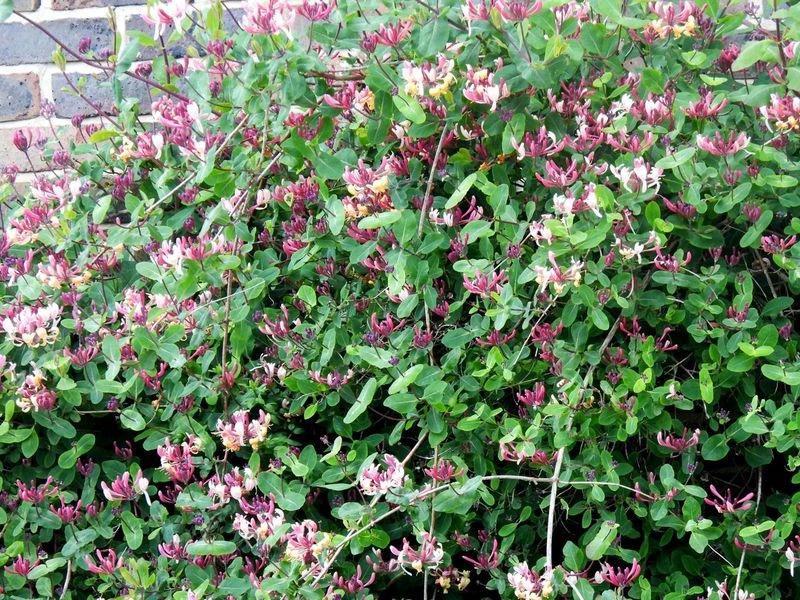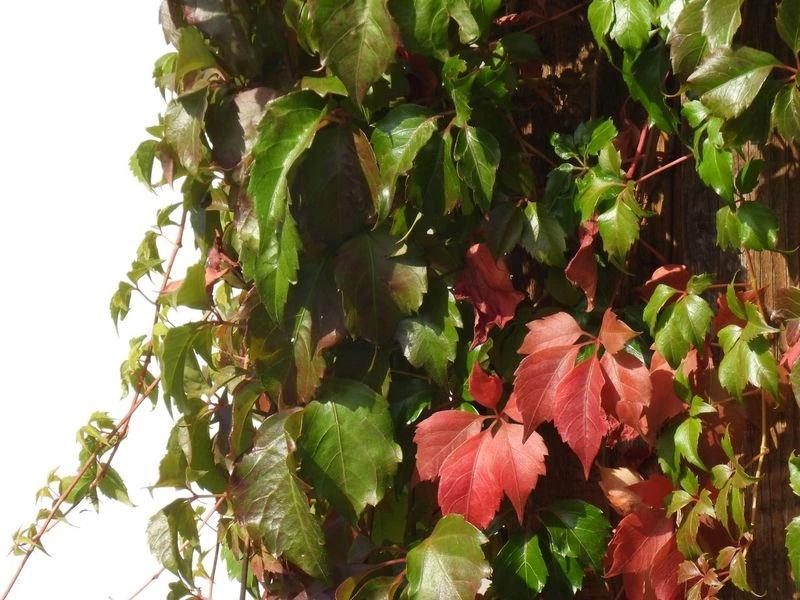Table of Contents
Shade Loving Climbers for North Facing Walls
The North Wall is tricky for growing plants up because it gets no direct sun.
This disadvantage often comes with dryness: rain-bearing winds mainly come from the South-West.
But with a little coaxing in the early years to get them established, there are plenty of climbing plants for the job.
Here’s a tip that we’ve found to be true in most cases: if a climber will grow on an East facing wall, it will almost certainly manage on a North facing one, although it may not flower as well.
Ivy: The Champion of Shade
Plain old green ivy is a bit dull, but variegated Paddy’s Pride (AKA Sulphur Heart) is reasonably jolly.
Ivy is self-clinging and does not damage new build bricks, it should only be avoided on old masonry that is already cracking.
Honeysuckles
Climbing Lonicera varieties frame a door on a North facing wall beautifully and fragrantly, although you will sacrifice some flowers compared to one grown in full sun.
They are twining vines, so need something to wind around as they climb.

One of the best honeysuckles for shade is the evergreen Lonicera japonica halliana.
The creamy Graham Thomas and late-flowering reddish-trumpeted Lonicera periclymenum Serotina also work well.
Perhaps the toughest and most striking is the golden-orange Lonicera x tellmanniana, but it lacks scent and so isn’t a first choice for doorways.
Clematis
Clematis are the queens of climbers. Many varieties have flowers that fade in the sun, and they love having their feet in the shade, as long as they have sufficient moisture.
Most clematis will be fine on a North facing wall, especially cultivars of Clematis alpina, Clematis macropetala, and the evergreen Clematis armandii.
Some of our favourites:
Like honeysuckle, Clematis needs support to scramble up.
Virginia Creepers

Parthenocissus varieties are great in the shade, although their Autumn show will be less striking. They aren’t for everyone due to their bonkers vigour, but covering the side of a house fast is their forte.
Climbing Hydrangeas
Hydrangea anomala sub petiolaris with its showy, lacy white flowers and its deep evergreen foliage is another cling-on.
It is pretty bulky and looks best when it’s allowed to bush out from the wall a fair bit.
Jasmines
Perhaps unexpectedly, certainly contrary to the RHS page for it, Trachelospermum jasminoides does well on a sheltered North facing wall.
The acid-yellow, winter flowering Jasmine nudiflorum is really best as a trailer rather than a climber, but also good in the shade.
Climbing Roses for Shade
Vita Sackville-West deployed the double white Madame Alfred Carriere as the silver bullet for her massive North facing wall at Sissinghurst to spectacular effect.
The following list is not exhaustive, just some of the best choices:
- Albertine: a rambler with salmon pink clusters of double flowers growing on reddish stems
- Madame Alfred Carriere: warm double white flowers that can take on a soft pink blush
- Climbing Iceberg: ice white flowers that do repeat all season
- New Dawn: climber with cupped double pearl-pink flowers
- Danse de Feu: climber with scarlet clusters of double flowers with abundant glossy foliage
- Golden Showers: a climber with pointed double yellow flowers that open in rosettes
- Zepherine Drouhin: cerise pink climbing rose – attach wires away from the wall to allow air circulation
- Gloire de Dijon: old climbing rose with large, creamy pink-orange flowers and a rich scent.
Wall Shrubs
Some good shrubs can be trained to ‘climb’ a North wall.
- Pyracanthas are excellent and can get pretty tall, as can Photinia Red Robin.
- Cotoneaster simonsii or Cotoneaster horizontalis are shorter, great for covering up to the first window.
Wire Trained Fruit Trees
Fruit tree fans (best for stone fruit) and espaliers (best for apples and pears), grown on wires, are not an obvious choice for a North facing wall, but you have a couple of options:
- The blue plum Czar will serve
- The cooking apples Early Victoria and Keswick Codlin are OK
- But the standout candidate is the Morello sour cherry, which probably produces better quality fruit in the shade than in full sun. The blossom looks wonderful in Spring.
